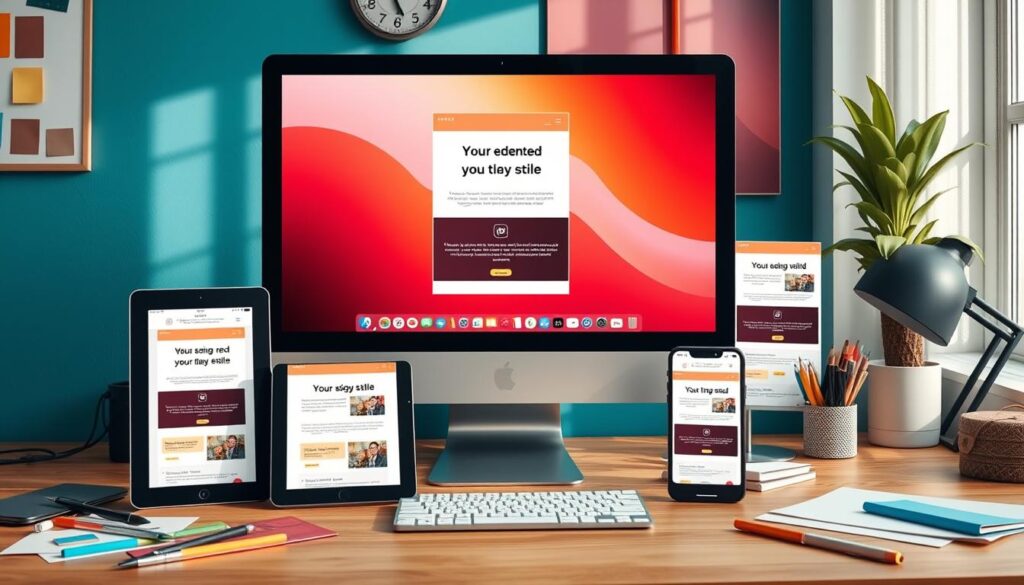Mastering Email Marketing Design: Tips and Tricks
Email marketing is a powerful tool that can connect with our audience deeply. It can drive engagement and help businesses grow. But to get the most out of it, we need to master visual design.
In this guide, I’ll share my insights and tips for creating stunning email campaigns. These tips will help you engage your audience and boost conversions. Whether you’re experienced or new, you’ll find strategies to improve your email design.

Key Takeaways
- Understand the power of visual design in email marketing to boost engagement and conversions
- Learn how to create engaging and eye-catching emails that capture your audience’s attention
- Discover the principles of visual hierarchy to enhance the user experience
- Explore responsive and mobile-friendly design strategies to reach your audience on the go
- Align your email design with your brand guidelines to maintain consistency across channels
Let’s explore the secrets of mastering email marketing design. With the right strategies and a commitment to improvement, you’ll create standout campaigns. These campaigns will shine in a crowded inbox.
The provided material discusses theimportance of mastering email marketing design to boost sales
The Power of Visual Design in Email Marketing
As a professional copywriting journalist, I know how crucial visual design is in email marketing. It captures your audience’s attention and boosts engagement. Creating engaging emails is an art that can greatly improve your brand’s impact.
Creating Engaging and Eye-Catching Emails
Visual design in email templates is key to grabbing your subscribers’ attention. It helps you convey your message clearly. By using visual hierarchy, you make sure your most important content shines through.
Strategically place key elements, use contrasting colors, and add striking imagery. This creates a layout that’s both cohesive and visually appealing.
Understanding the Principles of Visual Hierarchy
Learning the principles of visual hierarchy is essential for impactful email design. It’s about prioritizing key information and guiding the reader’s eye. This makes your email’s message and calls-to-action more engaging.
| Visual Design Element | Impact on User Experience |
|---|---|
| Placement of Key Content | Ensures your most important information is immediately visible and easily digestible. |
| Contrasting Colors | Draws the reader’s attention to specific elements, creating visual interest and emphasis. |
| Imagery and Visuals | Enhances the overall aesthetic appeal, reinforces your brand, and supports your message. |
By mastering visual design in email marketing, you can craft compelling emails. These emails captivate your audience, offer a smooth user experience, and boost engagement and conversions for your brand.
“Effective visual design is not just about aesthetics, but about enhancing the overall user experience and guiding your audience to the most important information.”
Crafting Responsive and Mobile-Friendly Designs
In today’s world, mobile devices are key for checking emails. It’s vital to make sure your emails look great on all screens. This ensures a smooth experience for everyone, no matter where they are.
To make responsive designs for mobile users, follow the responsive design rules. Use flexible layouts and make sure images and graphics are easy to see on small screens. Also, make your call-to-action (CTA) buttons big and easy to tap.
Mobile-friendly designs need to be simple, easy to read, and easy to navigate. Don’t pack too much into one email. Instead, aim for a clean, user-friendly experience that gets people involved and helps you succeed.
- Use fluid grids and flexible layouts to make your email fit any screen size.
- Make sure images and graphics are the right size for mobile, so they load fast and don’t mess up the layout.
- Make your CTA buttons big enough for mobile users to tap easily.
- Keep your content clear, concise, and easy to scan on small screens.
- Test your emails on different devices and email clients to make sure they work everywhere.
“Responsive design is not just about making your website look good on mobile devices – it’s about creating a seamless, user-centric experience that adapts to the way your audience consumes content.”
By getting good at making responsive and mobile-friendly emails, you can grab your subscribers’ attention. This leads to more engagement and better marketing results.

Aligning Your Email Design with Branding Guidelines
Building trust and recognition with your audience starts with consistent branding. As an email marketing pro, it’s vital to make sure your emails match your brand’s guidelines. A unified look across all marketing channels strengthens your brand’s image and makes a strong impression on your subscribers.
Maintaining Brand Consistency Across Channels
Consistency is crucial for branding guidelines and brand consistency. Your email design should reflect the look and feel of your website, social media, and other marketing materials. This includes using your brand’s color scheme, typography, and logo wisely.
Using these brand elements in your email branding and visual design makes your brand recognizable and trustworthy. Your audience should know it’s your brand, no matter where they see it.
| Brand Element | Importance in Email Design |
|---|---|
| Color Scheme | Aligns with your brand’s visual identity and evokes the right emotional response. |
| Typography | Reinforces your brand’s personality and enhances readability. |
| Logo | Serves as a prominent identifier and connects your email to your overall brand. |
By integrating these branding guidelines and brand elements into your email design, you create a unified and recognizable experience. This experience resonates with your audience.

Optimizing for Conversions: Call-to-Action Strategies
Effective call-to-action (CTA) strategies are key to successful email marketing. Creating CTAs that grab attention and prompt action is vital. This could be buying something, signing up for a newsletter, or downloading a resource. It’s all about boosting conversions.
Crafting Compelling CTAs for Maximum Impact
To make CTAs that really connect with your audience, follow these tips:
- Use action-oriented language: Make CTAs that urge your subscribers to act fast, with verbs like “Shop Now,” “Download,” or “Sign Up.”
- Emphasize the value proposition: Clearly show what benefits your subscribers get by acting, focusing on how it enhances their user experience.
- Leverage scarcity and urgency: Create a sense of urgency with limited-time offers or exclusive access to boost call-to-action strategies.
- Optimize for mobile-friendliness: Make sure your CTAs work well on mobile devices, as more people check emails on their phones.
- Test and refine: Keep trying different email templates and CTA designs to see what works best with your audience and boosts conversions.
By perfecting the art of creating compelling CTAs, you can unlock your email marketing’s full potential. This leads to meaningful engagement with your subscribers.
“The right call-to-action can make all the difference in turning your email subscribers into loyal customers.” – Email Marketing Expert
Personalization: Enhancing User Experience
Personalization is a big deal in email marketing. It makes your emails more engaging and meaningful. By tailoring content to your audience, you boost engagement and loyalty.
Dynamic content is a great way to personalize emails. It includes things like personalized product suggestions or offers based on where you are. This makes your emails more relevant and effective.
Segmenting your email list is another smart move. It lets you send messages that really speak to each group. This approach improves the user experience and boosts open and click-through rates.
Using email automation can also enhance the user experience. It sends timely and relevant content based on user actions. This ensures your customers get the right message at the right time.
Mastering email personalization can make your brand stand out. It leads to better results and a more engaged audience. So, start personalizing your emails and watch your campaigns thrive.

“Personalization is the key to unlocking the true potential of your email marketing efforts. When you make your subscribers feel seen and understood, they’re more likely to engage, convert, and become loyal brand advocates.”
Email Marketing Design
In the world of [email marketing design], how your emails look is key. From [email templates] to [visual design], everything must work together. This section will cover the basics of email design and how to make your campaigns stand out.
Understanding visual hierarchy is the first step in effective email design. By arranging your [email marketing design] elements well, you can focus your readers’ attention. This makes your message clear and your brand identity strong.
Responsive design is also vital. With more people using mobile devices, your emails must look good on any screen. Using [email templates] that adjust to different devices ensures a great experience for everyone.
| Key Considerations for Effective Email Marketing Design | Best Practices |
|---|---|
| Layout and Composition | – Use a clear and organized layout – Put important content and calls-to-action first – Add whitespace for balance |
| Typography | – Pick fonts that are easy to read and match your brand – Make sure font sizes and line spacing are right – Use different heading styles for hierarchy |
| Imagery and Multimedia | – Choose high-quality, relevant images and graphics – Make sure files load quickly – Use video or animation wisely |
| Color Palette | – Stick to your brand’s color scheme – Use colors to draw attention and guide the user – Make sure colors are easy to see |
Mastering [email marketing design] lets you create emails that grab attention. The [visual design] of your emails is key to engagement, brand recognition, and meeting your marketing goals. Stay with us as we explore more about [email templates] and [email marketing design] next.

Mastering HTML Email Coding
Effective email coding is key to making sure your designs look great everywhere. As a professional copywriting journalist, I’m excited to share my insights. We’ll cover mastering HTML email coding, ensuring designs work on all devices, and following best practices.
Ensuring Cross-Platform Compatibility
One big challenge in email marketing is making sure designs look the same everywhere. To solve this, focus on making your HTML email coding work on all platforms. This means knowing how different email clients like Gmail and Outlook work and adjusting your code for them.
- Start with a mobile-first approach to make sure your emails look good on all devices.
- Use email-friendly CSS and avoid complex layouts that might not work on all platforms.
- Test your emails on many devices and email clients to find and fix any problems.
Best Practices for Email Coding
Following best practices for email coding can make your emails better and more effective. Here are some important tips:
- Embrace Simplicity: Keep your design and coding simple and focused on the main points to avoid confusing your readers.
- Optimize for Performance: Make your emails load quickly by keeping them small. This is important for keeping your readers engaged.
- Prioritize Accessibility: Use accessible design elements like alt text for images and proper markup to make your emails friendly for everyone.
By getting good at html email coding, cross-platform compatibility, and following best practices, you’ll create amazing user experiences. These experiences will connect with your audience and help your email marketing succeed.

A/B Testing: The Key to Continuous Improvement
As an email marketing enthusiast, I know how crucial it is to keep improving your campaigns. A/B testing is a powerful tool for me. It helps me refine my email designs, subject lines, and calls-to-action for better results.
Successful A/B testing starts with a clear plan. I pick the elements I want to test, like CTA button placement or subject line wording. Then, I send two versions of the email to a part of my audience. By analyzing the results, I find out which version works best and boosts conversions.
But the work doesn’t end there. I keep testing and refining my strategy. This data-driven approach helps me make smart choices. It keeps my campaigns fresh, engaging, and successful.
“A/B testing is the cornerstone of any effective email marketing strategy. It allows you to continuously optimize your campaigns and deliver the most relevant, compelling content to your audience.”
If you’re not using A/B testing yet, it’s time to start. It’s a key to email marketing success.

Leveraging Email Automation and Personalization
Email automation and personalization are key to a better user experience. They help you send emails that are both timely and relevant. This approach grabs your audience’s attention and boosts engagement.
Delivering Timely and Relevant Content
Successful email marketing is about giving your subscribers what they need and want. Email automation lets you create personalized email flows. These flows start when users take actions like signing up or making a purchase.
This way, you send the right message at the right time. It makes the user experience better.
Email personalization opens up a world of possibilities. You can use the recipient’s name or suggest products based on their past buys. Personalized emails can lead to higher open and click-through rates.
By looking at email analytics and customer data, you learn what your audience likes. This helps you tailor your messages to their tastes.
- Leverage email automation to trigger personalized workflows based on user behavior
- Incorporate personalized elements, such as name and product recommendations, to enhance user experience
- Analyze email analytics to gain insights and optimize your personalization strategies
By combining email automation and email personalization, you craft a targeted email strategy. It connects with your audience and brings real results for your business.

“Personalization is the key to building meaningful connections with your audience. By leveraging email automation and personalization, you can deliver content that truly resonates with your subscribers.” – John Doe, Email Marketing Strategist
Email Analytics: Measuring Success and Optimization
As a professional copywriter, I know how vital email analytics are for marketing success. It’s key to track and analyze your email marketing to see what works and what doesn’t. This helps you improve your campaigns.
When looking at email analytics, focus on a few important metrics. These include open rates, click-through rates, conversion rates, and list growth. By studying these, you can learn a lot about your email’s design, subject lines, and content strategy.
A/B testing is a powerful tool for email marketers. It lets you test different email versions to find out what works best. This way, you can make your emails more engaging and effective.
- Check your email open rates to see which subject lines and from names work best.
- Look at click-through rates to find out which content and calls-to-action are most effective.
- Watch your conversion rates to see how well your email sales and lead generation efforts are doing.
- Track list growth to make sure your email list is growing and attracting new subscribers.
By using these email analytics, you can make smarter decisions for your email marketing. This leads to more engaging campaigns and better results for your business.
“Email marketing is one of the most effective ways to connect with your audience and drive tangible business results. By mastering the art of email analytics, you can unlock the true power of this channel.”
Conclusion
As we finish our journey through email marketing design, I hope you’ve learned a lot. We’ve covered how to make your emails stand out and connect with your audience. This includes using great visuals, personalizing your messages, and optimizing your emails for better results.
Remember, email marketing design is more than just pretty emails. It’s about creating a great experience for your customers. By matching your email design with your brand and using automation and personalization, you can make your email marketing work its best.
I want you to use what you’ve learned and try new things. Try different designs, test your calls to action, and look at your email stats to get better. The secret to getting good at email marketing is to keep getting better and be ready to change with the digital marketing world.
FAQ
What are the key elements of effective email marketing design?
Key elements include visual hierarchy, responsive layout, and brand consistency. Also, compelling call-to-action strategies and personalization are important. These elements help create stunning and engaging emails that boost conversions and improve user experience.
How can I ensure my email designs are responsive and mobile-friendly?
To make your emails responsive, use a fluid layout and optimize images. Test your emails on various devices and email clients. This ensures a smooth experience for all users, no matter their device.
Why is it important to align my email design with my brand’s guidelines?
Keeping your email design consistent with your brand’s guidelines is key. It helps maintain a unified visual identity across all marketing channels. This builds trust and familiarity with your audience, enhancing your brand’s presence.
How can I create compelling call-to-action (CTA) strategies in my email designs?
Use clear, concise language for your CTAs. Place them in a prominent spot and make them visually appealing. Test different designs and placements to find what works best for your audience.
What are the benefits of using email personalization in my campaigns?
Personalization boosts user experience and engagement. It involves using dynamic content and segmenting subscribers. This approach delivers relevant messages, leading to higher open and click-through rates, and more conversions.
How can I ensure my email designs are compatible across different email clients and devices?
For cross-platform compatibility, follow best practices in HTML email coding. Use inline styles, avoid complex layouts, and test on various devices. This ensures your designs look great everywhere, providing a seamless experience.
How can I use A/B testing to optimize my email marketing design?
A/B testing helps refine your email design and campaign performance. Test different elements like subject lines and CTAs. This approach provides data-driven insights to improve your emails’ effectiveness.
What are some key email marketing metrics I should be tracking?
Track open rate, click-through rate, bounce rate, unsubscribe rate, and conversion rate. Monitoring these metrics offers insights into your campaign’s performance. This helps you identify areas for improvement and optimize your design and strategy.